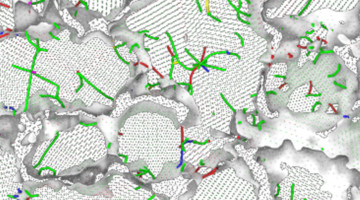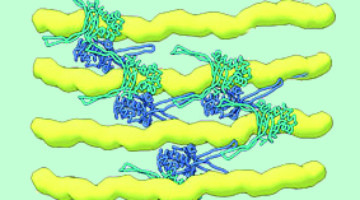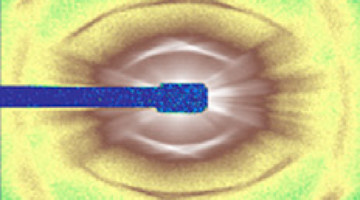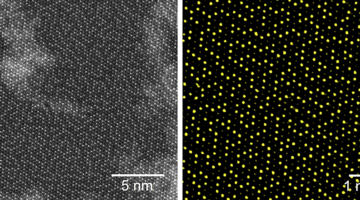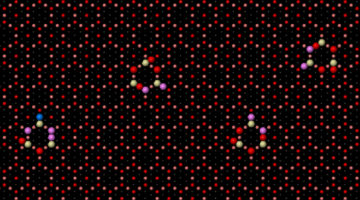Researchers used in situ high-pressure diffraction to resolve a debate about whether a metal’s strength increases or decreases when its grain size decreases below a critical point. The results indicate that ultrastrong metals for future applications can indeed be achieved through grain-size refinement and grain-boundary engineering. Read more »
How Proteins Remodel DNA in Bacteria under Stress
Multiscale, multimodal visualization techniques at the ALS enabled researchers to clarify how proteins remodel bacterial DNA in response to stressful environments. The discovery could lead to new strategies for controlling microbial behavior and, eventually, new ways to fight bacterial infections. Read more »![]()
![]()
Toughening Mechanisms in Carp Scales at the Nanoscale
Scientists have characterized carp scales down to the nanoscale, using the ALS to watch how the fibers in the scales react as stress is applied. The resulting insights provide inspiration for the design of advanced synthetic structural materials with unprecedented toughness and penetration resistance. Read more »![]()
![]()
2D Electronics Get an Atomic Tuneup
Researchers demonstrated a promising avenue for controlling atomic ordering in semiconductor alloys by engineering frustrated interactions in a 2D transition metal dichalcogenide (TMD). The work could lead to improved semiconductor performance for next-generation electronics such as optoelectronics, thermoelectrics, and sensors. Read more »
Reversible Room-Temperature Fluoride-Ion Insertion in a Tunnel-Structured Transition Metal Oxide Host
Fluoride ions show promise as charge carriers in batteries but have limited cyclability. Here we show the reversible and homogeneous topochemical insertion/deinsertion and bulk diffusion of F ions within the one-dimensional tunnels of submicrometer-sized FeSb2O4 particles at room temperature. Read more »
Thermoinduced Crystallization-Driven Self-Assembly of Bioinspired Block Copolymers in Aqueous Solution
Thermoinduced crystallization-driven self-assembly of polypeptoid-based block copolymers results in delicate control over the nanostructure in aqueous solution. This provides a convenient platform for comparing cellular uptake efficiency of nanostructured assemblies with various morphologies that are otherwise similar. Read more »
Structural Features Mediating Zinc Binding and Transfer in the AztABCD Zinc Transporter System
Zinc homeostasis is critical for bacterial survival and virulence. Extracellular zinc-binding proteins play an important role in this process. This work assesses the role of several flexible or unstructured sequences in zinc binding and transfer from proteins AztD to AztC. The results provide insights into the dynamic nature of these processes and support a previously proposed structural model of transfer. Read more »
A Closer Look at Water-Splitting’s Solar Fuel Potential
Although bismuth vanadate (BiVO4) is a theoretically attractive material for electrodes in photoelectric chemical cells (PECs) used for artificial photosynthesis, it hasn’t lived up to its potential. Researchers used a multimodal approach to gain new insight into what might be happening at the nanoscale to hold BiVO4 back. Read more »
ALS in the News (July 2020)
-
-
- Berkeley Lab part of multi-institutional team awarded $60M for solar fuels research
- An origin story for a family of oddball meteorites
- New technique to capture CO2 could reduce power plant greenhouse gases
- Princeton scientists discover a topological magnet that exhibits exotic quantum effects
- Battery breakthrough gives boost to electric flight and long-range electric cars
- Building blocks for COVID-19 antiviral drugs identified in rapid study
- Scientists dive deep into hidden world of quantum states
- Michael V. Drake to become 21st president of the University of California
- Deterministic reversal of single magnetic vortex circulation by an electric field
- Study gains new insight into bacterial DNA packing
- Ultrafine control: researchers discover ferroelectricity at the atomic scale
- Finding the missing step of an important molecular process
- Pilot 1 workers on site share thoughts [video]
- Employees commit to the Berkeley Lab Health Pledge [video]
- Deep look inside the tsetse fly
-
How Water Promotes Catalysis of Methane to Methanol
Researchers unraveled how water helps catalyze the conversion of methane, the main component of natural gas, into methanol, a liquid fuel. The work supports the efficient production of methanol and other useful chemicals and could help reduce the amount of greenhouse gases released by the flaring and venting of methane. Read more »![]()
![]()
- « Previous Page
- 1
- …
- 40
- 41
- 42
- 43
- 44
- …
- 83
- Next Page »
